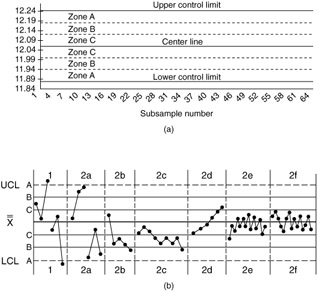OTHER OUT-OF-CONTROL INDICATIONS
OTHER OUT-OF-CONTROL INDICATIONS
To this point, the only formal indication of an out-of-control process is a point beyond the control limits. There are a number of other possible indications of "nonrandom" behavior that we might want to react to. The usual ones that have been suggested include:
-
At least seven upward (or downward) consecutive changes
-
At least seven consecutive points above (or below) the centerline
-
At least two of three consecutive points beyond two standard deviations from the centerline (where both are on the same side of the centerline); usually applied only to Xbar charts
-
At least 4 of 5 consecutive points beyond one standard deviation from the centerline (where all 4 are on the same side of the center line); usually applied only to Xbar charts
For these last two conditions, it is common to divide the region between the center-line and either control limit into three "zones" of width one standard deviation each, as indicated in Figure 11.9. (Figure 11.9a shows the zones, and Figure 11.9b shows the distribution of points that are out of control.) Then Condition 3 is called the Zone A rule, and Condition 4 is called the Zone B rule. In either case, the idea is that although points within Zone A and Zone B are within the control limits, it is unlikely that an in-control process would have this many nearby points in Zone A or B.

Figure 11.9: A typical control chart divided into zones.
Most computer programs have built-in alarms when they analyze the control charts. The alarms, depending on the software package, may be a different color , a letter, or even a number code for each of the signals we have discussed in here. However, we do not want to overemphasize these (or any other) possible indications of out of-control behavior. The more such conditions that we check for, the more likely that we will find false alarms. In a real situation, an experienced operator is likely to give different emphasis to different out-of-control indications. For example, if the operator sees any of the above conditions but no points beyond the control limits, he or she might start sampling more frequently ”every 15 minutes instead of every 30 minutes, say. If he then continues to see more instances of these conditions or to see points beyond the control limits, he might start searching for assignable causes and possible fixes.
Typical assignable causes are
| Broken tool | Chips |
| Clamps not working | Handling damage |
| Improper cycle time | Improper maintenance |
| Incorrect feed rate | Over/under adjustment |
| Change over | Bearing loose or worn |
| Worn chip locators | Worn wear plates |
| Defective tools | Hard or soft stock |
| Tool adjustment | Tool change |
| Runout | Loose tooling |
| Out of balance | Tool wear |
| Unknown | Belts |
| Incorrect speed rate | Calibration error |
| Grind wheel needs change | Temperature change (environment) |
| Gage-gage error | Low or high air pressure |
| Improper lubrication | Taper problem |
| Previous operation defect | Low or high hydraulic pressure |
| Spindle bearings | Collect change or repair |
| Incoming stock variation | Pressure or load adjustment |
| Worn bushings | Loose gibbs |
| Out of alignment | Supplier defects |
| Improper coolant | Rust or contamination |
EAN: 2147483647
Pages: 181